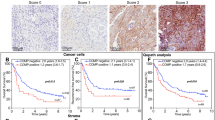Abstract
Background
Colon cancer (CC) is the third most commonly diagnosed cancer in the USA. While the overall incidence is declining, it is rising alarmingly in young patients (EOCC). CC in young patients tends to be more aggressive and often diagnosed at more advanced stages and portend poorer prognosis. Our recently published data showed that EOCC is a distinct disease with unique molecular features compared to late-onset CC (LOCC). The Cartilage Oligomeric Matrix Protein (COMP) was shown to be significantly upregulated in EOCC and correlated with poor survival. However, the role of COMP in CC tumorigenesis, especially in young patients, is not well understood. Thus, the aim of this study was to elucidate the role of COMP in CC tumorigenesis by modulating COMP levels in vitro and test how it affects proliferation. Then, patient samples were evaluated by testing the levels of proliferation marker Ki67. In addition, this study investigates whether higher transcriptional mRNA levels of COMP seen in more aggressive early-onset CC correlate with protein levels compared to late-onset CC.
Methods
COMP mRNA levels in fresh frozen colon tumors (young: n = 5; old: n = 5) were assessed by quantitative PCR (qPCR). Additionally, CC cell lines were profiled for COMP expression to choose an in vitro model to study the role of COMP in CC tumorigenesis. HT-29 (low COMP expression) and CaCo-2 (high COMP expression) cells were used for in vitro proliferation studies. Immunohistochemical (IHC) analysis was conducted to assess COMP and Ki67 protein levels in formalin-fixed paraffin-embedded (FFPE) colon tumors.
Results
Significantly higher COMP expression levels were observed in fresh frozen EOCC compared to LOCC tumors. This observation confirmed our previously reported results from NanoString gene expression assay using FFPE samples. Cell proliferation was significantly increased in HT-29 and CaCo-2 cells upon treatment with human recombinant COMP protein after 48 and 72 h (P < 0.05). This increase was more profound in HT-29 cells. Staining for COMP and Ki67 revealed high COMP protein levels in EOCC compared to LOCC patients.
Conclusion
COMP mRNA and protein levels are significantly higher in EOCC patients. Higher COMP levels correlate with increased proliferation suggesting a role in CC tumorigenesis.







Similar content being viewed by others
References
Siegel RL et al (2017) Colorectal cancer statistics, 2017. CA 67(3):177–193
Brenner H, Kloor M, Pox CP (2014) Colorectal cancer. Lancet 383(9927):1490–1502
Schreuders EH et al (2015) Colorectal cancer screening: a global overview of existing programmes. Gut 64(10):1637–1649
Kirzin S et al (2014) Sporadic early-onset colorectal cancer is a specific sub-type of cancer: a morphological, molecular and genetics study. PLoS ONE 9(8):e103159
Davis DM et al (2011) Is it time to lower the recommended screening age for colorectal cancer? J Am Coll Surg 213(3):352–361
Chang DT et al (2012) Clinicopathologic and molecular features of sporadic early-onset colorectal adenocarcinoma: an adenocarcinoma with frequent signet ring cell differentiation, rectal and sigmoid involvement, and adverse morphologic features. Mod Pathol 25(8):1128–1139
Myers EA et al (2013) Colorectal cancer in patients under 50 years of age: a retrospective analysis of two institutions’ experience. World J Gastroenterol 19(34):5651–5657
Jandova J, Xu W, Nfonsam V (2016) Sporadic early-onset colon cancer expresses unique molecular features. J Surg Res 204(1):251–260
Tseng S, Reddi AH, Di Cesare PE (2009) Cartilage oligomeric matrix protein (COMP): a biomarker of arthritis. Biomark Insights 4:33–44
Acharya C et al (2014) Cartilage oligomeric matrix protein and its binding partners in the cartilage extracellular matrix: interaction, regulation and role in chondrogenesis. Matrix Biol 37:102–111
Englund E et al (2016) Cartilage oligomeric matrix protein contributes to the development and metastasis of breast cancer. Oncogene 35(43):5585–5596
Englund E et al (2017) Cartilage oligomeric matrix protein promotes prostate cancer progression by enhancing invasion and disrupting intracellular calcium homeostasis. Oncotarget 8(58):98298–98311
Liu TT et al (2018) Cartilage oligomeric matrix protein is a prognostic factor and biomarker of colon cancer and promotes cell proliferation by activating the Akt pathway. J Cancer Res Clin Oncol 144(6):1049–1063
Tsai KS et al (2010) Type I collagen promotes proliferation and osteogenesis of human mesenchymal stem cells via activation of ERK and Akt pathways. J Biomed Mater Res Part A 94(3):673–682
Halasz K et al (2007) COMP acts as a catalyst in collagen fibrillogenesis. J Biol Chem 282(43):31166–31173
Somaiah C et al (2015) Collagen promotes higher adhesion, survival and proliferation of mesenchymal stem cells. PLoS ONE 10(12):e1045068
Senoo H, Hata R (1994) Extracellular matrix regulates cell morphology, proliferation, and tissue formation. Kaibogaku Zasshi 69(6):719–733
Holden P et al (2001) Cartilage oligomeric matrix protein interacts with type IX collagen, and disruptions to these interactions identify a pathogenetic mechanism in a bone dysplasia family. J Biol Chem 276(8):6046–6055
Agarwal P et al (2012) Collagen XII and XIV, new partners of cartilage oligomeric matrix protein in the skin extracellular matrix suprastructure. J Biol Chem 287(27):22549–22559
Jandova J, Nfonsam V (2016) Comprehensive genomic analysis of colon tumors reveals differences in molecular patterns between early- and late-onset tumors. Ann Surg Oncol 23:S75
Acknowledgements
We would like to thank the patients without whom this work would not have been possible.
Funding
This work was supported by the SAGES research grant awarded to VNN.
Author information
Authors and Affiliations
Contributions
VNN—conception and design; PNO, HCJ—data acquisition; JJ—IHC data acquisition; LEN, EE, AJS—manuscript review; JJ—design, conception, manuscript preparation, data interpretation, data analysis.
Corresponding author
Ethics declarations
Disclosures
V.N. Nfonsam, H.C. Jecius, J. Janda, P. N. Omesiete, E. Elquza, A.J. Scott, L. E. Nfonsam, and J. Jandova, declare no conflict of interest or financial ties to disclose.
Additional information
Publisher's Note
Springer Nature remains neutral with regard to jurisdictional claims in published maps and institutional affiliations.
Rights and permissions
About this article
Cite this article
Nfonsam, V.N., Jecius, H.C., Janda, J. et al. Cartilage oligomeric matrix protein (COMP) promotes cell proliferation in early-onset colon cancer tumorigenesis. Surg Endosc 34, 3992–3998 (2020). https://doi.org/10.1007/s00464-019-07185-z
Received:
Accepted:
Published:
Issue Date:
DOI: https://doi.org/10.1007/s00464-019-07185-z




